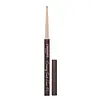What's inside
What's inside
 Key Ingredients
Key Ingredients

 Benefits
Benefits

 Concerns
Concerns

 Ingredients Side-by-side
Ingredients Side-by-side

Methyl Trimethicone
Skin ConditioningTrimethylsiloxysilicate
EmollientAcrylates/Stearyl Acrylate/Dimethicone Methacrylate Copolymer
Polyethylene
AbrasiveCopernicia Cerifera Wax
Euphorbia Cerifera Wax
Dimethicone
EmollientHydrogenated Lecithin
EmulsifyingSilica
AbrasiveMethyl Methacrylate Crosspolymer
Tocopherol
AntioxidantSimmondsia Chinensis Seed Oil
EmollientSqualane
EmollientMacadamia Ternifolia Seed Oil
EmollientMethicone
EmollientSodium Hyaluronate
HumectantAluminum Hydroxide
EmollientBHT
AntioxidantCI 77491
Cosmetic ColorantCI 77492
Cosmetic ColorantCI 77499
Cosmetic ColorantMica
Cosmetic ColorantCI 77891
Cosmetic ColorantMethyl Trimethicone, Trimethylsiloxysilicate, Acrylates/Stearyl Acrylate/Dimethicone Methacrylate Copolymer, Polyethylene, Copernicia Cerifera Wax, Euphorbia Cerifera Wax, Dimethicone, Hydrogenated Lecithin, Silica, Methyl Methacrylate Crosspolymer, Tocopherol, Simmondsia Chinensis Seed Oil, Squalane, Macadamia Ternifolia Seed Oil, Methicone, Sodium Hyaluronate, Aluminum Hydroxide, BHT, CI 77491, CI 77492, CI 77499, Mica, CI 77891
Trimethylsiloxysilicate
EmollientIsododecane
EmollientSynthetic Fluorphlogopite
Candelilla Wax Hydrocarbons
Copernicia Cerifera Wax
Diphenylsiloxy Phenyl Trimethicone
Skin ConditioningSynthetic Wax
AbrasiveEuphorbia Cerifera Cera
AstringentDipentaerythrityl Pentaisostearate
EmollientHydrogenated Polyisobutene
EmollientTocopherol
AntioxidantDimethicone
EmollientMica
Cosmetic ColorantTitanium Dioxide
Cosmetic ColorantCI 77492
Cosmetic ColorantPotassium Hydroxide
BufferingCI 45380
Cosmetic ColorantTrimethylsiloxysilicate, Isododecane, Synthetic Fluorphlogopite, Candelilla Wax Hydrocarbons, Copernicia Cerifera Wax, Diphenylsiloxy Phenyl Trimethicone, Synthetic Wax, Euphorbia Cerifera Cera, Dipentaerythrityl Pentaisostearate, Hydrogenated Polyisobutene, Tocopherol, Dimethicone, Mica, Titanium Dioxide, CI 77492, Potassium Hydroxide, CI 45380
 Reviews
Reviews

Ingredients Explained
These ingredients are found in both products.
Ingredients higher up in an ingredient list are typically present in a larger amount.
Ci 77492 is also hydrated iron III oxide. It's sole purpose is to give a yellow hue to products.
Iron III oxides are classified as inorganic chemicals for coloring.
Synthetically created Ci 77492 is considered safer than those naturally found. This is because the synthetically created version may contain less impurities. Iron oxides are generally non-toxic and non-allergenic.
Learn more about CI 77492Copernicia Cerifera Wax comes from a palm tree native to Brazil; another name for this ingredient is Carnauba Wax.
This ingredient is used to thicken texture and also leaves behind a film when applied.
Fun fact: This wax has the highest melting point of all natural waxes and low solubility.
Learn more about Copernicia Cerifera WaxDimethicone is a type of synthetic silicone created from natural materials such as quartz.
What it does:
Dimethicone comes in different viscosities:
Depending on the viscosity, dimethicone has different properties.
Ingredients lists don't always show which type is used, so we recommend reaching out to the brand if you have questions about the viscosity.
This ingredient is unlikely to cause irritation because it does not get absorbed into skin. However, people with silicone allergies should be careful about using this ingredient.
Note: Dimethicone may contribute to pilling. This is because it is not oil or water soluble, so pilling may occur when layered with products. When mixed with heavy oils in a formula, the outcome is also quite greasy.
Learn more about DimethiconeMica is a naturally occurring mineral used to add shimmer and color in cosmetics. It can also help improve the texture of a product or give it an opaque, white/silver color.
Serecite is the name for very fine but ragged grains of mica.
This ingredient is often coated with metal oxides like titanium dioxide. Trace amounts of heavy metals may be found in mica, but these metals are not harmful in our personal products.
Mica has been used since prehistoric times throughout the world. Ancient Egyptian, Indian, Greek, Roman, Aztec, and Chinese civilizations have used mica.
Learn more about MicaTocopherol (also known as Vitamin E) is a common antioxidant used to help protect the skin from free-radicals and strengthen the skin barrier. It's also fat soluble - this means our skin is great at absorbing it.
Vitamin E also helps keep your natural skin lipids healthy. Your lipid skin barrier naturally consists of lipids, ceramides, and fatty acids. Vitamin E offers extra protection for your skin’s lipid barrier, keeping your skin healthy and nourished.
Another benefit is a bit of UV protection. Vitamin E helps reduce the damage caused by UVB rays. (It should not replace your sunscreen). Combining it with Vitamin C can decrease sunburned cells and hyperpigmentation after UV exposure.
You might have noticed Vitamin E + C often paired together. This is because it is great at stabilizing Vitamin C. Using the two together helps increase the effectiveness of both ingredients.
There are often claims that Vitamin E can reduce/prevent scarring, but these claims haven't been confirmed by scientific research.
Learn more about TocopherolThis silicone is an emollient. Emollients create a thin film on the skin to prevent moisture from escaping.
It is not soluble in water and helps increase water-resistance in products.
According to a manufacturer, it can blend seamlessly with silicone oils, such as Cyclopentasiloxane.
Learn more about Trimethylsiloxysilicate